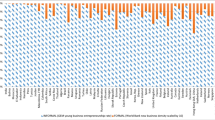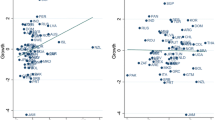Abstract
We investigated the influence of economic and political institutions on the prevalence rate of formal and informal entrepreneurship across 18 countries in the Asia-Pacific region during the period 2001–2010. We found the quality of institutions to exercise a substantial influence on both formal and informal entrepreneurship. One standard-deviation increase in the quality of economic and political institutions could double the rates of formal entrepreneurship and halve the rates of informal entrepreneurship. The two types of institutions had a complementary effect on driving entry into formal entrepreneurship, whereas only direct effects were observed for informal entry.

Similar content being viewed by others
Notes
Consistent with theory in institutional economics, we assume that entrepreneurs are boundedly rational. Although they seek to make choices that maximize their utility, such choices are not necessarily optimal given incomplete information and cognitive limitations.
GEM asks whether the individual’s business has paid salaries to anyone during the past 3 calendar years. Because the survey is carried out in June, this means that GEM’s new entrepreneur rate captures new entrepreneurs whose businesses are between 0 and 3.5 years (42 months) of age.
We did not control for GDP per capita because this correlated strongly with the quality of political and economic institutions. However, the joint effect of population size and GDP level indirectly captures this effect.
The overlap between the GEM Survey and the World Bank Enterprise Survey is not perfect, so we were able to use only seven years of the data.
We conducted a similar test using the larger sample of 67 countries worldwide (p = .802) and reached the same conclusion.
References
Acemoglu, D., & Robinson, J. A. 2012. Why nations fail: The origins of power, prosperity and poverty. London: Profile Books.
Acs, Z. J., & Amorós, J. E. 2008. Entrepreneurship and competitiveness dynamics in Latin America. Small Business Economics, 31(3): 305–322.
Acs, Z., Autio, E., & Szerb, L. 2014a. National systems of entrepreneurship: Measurement issues and policy implications. Research Policy, 43(1): 476–494.
Acs, Z., Szerb, L., & Autio, E. 2014b. Global entrepreneurship and development index. Washington, DC: Global Entrepreneurship and Development Institute (http://www.amazon.co.uk/dp/1496176413).
Acs, Z., Desai, S., & Klapper, L. 2008. What does “entrepreneurship” data really show? A comparison of the global entrepreneurship monitor and world bank group datasets. Small Business Economics, 31(3): 219–239.
Ahlstrom, D. 2010. Innovation and growth: How business contributes to society. Academy of Management Perspectives, 24(3): 10–23.
Ahlstrom, D., & Ding, Z. 2014. Entrepreneurship in China: An overview. International Small Business Journal, 32(6): 1–9.
Ahlstrom, D., Young, M. N., Chan, E. S., & Bruton, G. D. 2004. Facing constraints to growth? Overseas Chinese entrepreneurs and traditional business practices in East Asia. Asia Pacific Journal of Management, 21(3): 263–285.
Ahlstrom, D., Young, M. N., Nair, A., & Law, P. 2003. Managing the institutional environment: Challenges for foreign firms in post-WTO China. SAM Advanced Management Journal, 68(1): 41–49.
Ahluwalia, M. S., Carter, N. G., & Chenery, H. B. 1979. Growth and poverty in developing countries. Journal of Development Economics, 6(3): 299–341.
Ahmad, N., & Hoffmann, A. 2008. A framework for addressing and measuring entrepreneurship OECD statistics. Working paper no. 2, OECD, Paris.
Aiken, L. S., & West, S. G. 1991. Multiple regression: Testing and interpreting interactions. Thousand Oaks: Sage.
Anderson, J. H. 1998. The size, origins, and character of Mongolia’s informal sector during the transition. Policy research working paper no. 1916, World Bank, Washington, DC.
Anderson, W. H. L. 1964. Trickling down: The relationship between economic growth and the extent of poverty among american families. Quarterly Journal of Economics, 78(4): 511–524.
Argandona, A. 1999. Business ethics in Spain. Journal of Business Ethics, 22(3): 155–173.
Autio, E. 2007. GEM 2007 global report on high-growth entrepreneurship. London: Babson College and London Business School.
Autio, E., & Acs, Z. 2010. Intellectual property protection and the formation of entrepreneurial growth aspirations. Strategic Entrepreneurship Journal, 4(3): 234–251.
Autio, E., & Fu, K. 2012. Allocation of effort into informal entrepreneurship: Institutional and individual-level effects. Working paper, Imperial College Business School, London.
Autio, E., Pathak, S., & Wennberg, K. 2013. Consequences of cultural practices for entrepreneurial behaviors. Journal of International Business Studies, 44(4): 334–362.
Ayotte, K. 2007. Bankruptcy and entrepreneurship: The value of a fresh start. Journal of Law, Economics, and Organization, 23(1): 161–185.
Baumol, W. J. 1990. Entrepreneurship: Productive, unproductive, and destructive. Journal of Political Economy, 98(5): 893–921.
Baumol, W. J., & Strom, R. J. 2007. Entrepreneurship and economic growth. Strategic Entrepreneurship Journal, 1(1): 233–237.
Becker, K. F. 2004. The informal economy. Stockholm: Swedish International Development Agency.
Bowen, H. P., & De Clercq, D. 2008. Institutional context and the allocation of entrepreneurial effort. Journal of International Business Studies, 39(1): 1–21.
Bruton, G. D., Ahlstrom, D., & Li, H. 2010. Institutional theory and entrepreneurship: Where are we now and where do we need to move in the future?. Entrepreneurship Theory and Practice, 34(3): 421–440.
Bruton, G. D., Ketchen, D. J., & Ireland, R. D. 2013. Entrepreneurship as a solution to poverty. Journal of Business Venturing, 28(6): 683–689.
Byung-Yeon, K. 2005. Poverty and informal economy participation. Economics of Transition, 13(1): 163–185.
Capelleras, J.-L., Mole, K. F., Greene, F. J., & Storey, D. J. 2008. Do more heavily regulated economies have poorer performing new ventures? Evidence from Britain and Spain. Journal of International Business Studies, 39(4): 688–704.
Cassar, G. 2006. Entrepreneur opportunity costs and intended venture growth. Journal of Business Venturing, 21(5): 610–632.
Cohen, J., & Cohen, P. 1983. Applied multiple regression/correlation analysis for the behavioral sciences. Hillsdale, NJ: Lawrence Erlbaum Associates.
Cumming, D. J., Knill, A. M., & Richardson, N. T. 2011. Firm size, institutional quality and the impact of securities regulation. Working paper. Available at SSRN: http://ssrn.com/abstract=1572655 or http://dx.doi.org/10.2139/ssrn.1572655.
Daniels, S. 2010. Making do: Innovation in Kenya’s informal economy. New York: Analogue Digital.
de Soto, H. 1989. The other path: The invisible revolution in the Third world. New York: Harper and Row.
de Soto, H. 2000. The mystery of capital: Why capitalism triumphs in the west and fails everywhere else. London: Black Swan.
de Soto, H. 2002. The other path: The economic answer to terrorism. London: Harper and Row.
Djankov, S., Glaeser, E., La Porta, R., Lopez-de-Silanes, F., & Shleifer, A. 2003a. The new comparative economics. Journal of Comparative Economics, 31(4): 595–619.
Djankov, S., La Porta, R., Lopez-de-Silanes, F., & Shleifer, A. 2002. The regulation of entry. Quarterly Journal of Economics, 117: 453–517.
Djankov, S., Lieberman, I., Mukherjee, J., & Nenova, T. 2003b. Going informal: Benefits and costs. In B. Belev (Ed.). The informal economy in the EU accession countries: Size, scope, trends and challenges to the process of EU enlargement. Sofia, BG: Center for the Study of Democracy.
Djankov, S., Qian, Y., Roland, G., & Zhuravskaya, E. 2006. Who are China’s entrepreneurs?. American Economic Review, 96(2): 348–352.
Economic and Social Commission for Asia and the Pacific. 2006. Poverty and the informal sector: Role of the informal sector in poverty reduction. Committee on Poverty Reduction (Third Session), Bangkok, Thailand, November 29—December 1. http://www.unescap.org/pdd/CPR/CPR2006/English/CPR3_1E.pdf, Accessed on Aug. 1, 2013.
Estrin, S., Korosteleva, J., & Mickiewicz, T. 2013. Which institutions encourage entrepreneurial growth aspirations?. Journal of Business Venturing, 28(4): 564–580.
Estrin, S., & Mickiewicz, T. 2012. Shadow economy and entrepreneurial entry. Review of Development Economics, 16(4): 559–578.
Fajnzylber, P., Maloney, W. F., & Montes-Rojas, G. V. 2011. Does formality improve micro-firm performance? Evidence from the Brazilian SIMPLES program. Journal of Development Economics, 94(2): 262–276.
Farr, W. K., Lord, R. A., & Wolfenbarger, J. L. 1998. Economic freedom, political freedom, and economic well-being: a causality analysis. CATO Journal, 18(2): 247–262.
Feng, Y. 2002. Political freedom, political instability, and policy uncertainty: A study of political institutions and private investment in developing countries. International Studies Quarterly, 45(2): 271–294.
Friedman, M. 1962. Capitalism and freedom. Chicago: University of Chicago Press.
Gentry, W. M., & Hubbard, R. G. 2000. Tax policy and entrepreneurial entry. American Economic Review, 90(2): 283–287.
Giannetti, M., & Simonov, A. 2009. Social interactions and entrepreneurial activity. Journal of Economics & Management Strategy, 18(3): 665–709.
Godfrey, P. C. 2011. Toward a theory of the informal economy. Academy of Management Annals, 5(1): 231–277.
Hasan, R., Mitra, D., & Ulubasoglu, M. 2007. Institutions and policies for growth and poverty reduction: The role of private sector development. Asian Development Review, 24(1): 69–116.
Hasan, R., Quibria, M. G., & Kim, Y. 2003. Poverty and economic freedom: Evidence from cross-country data. Working paper, economics series, no. 60, East–West Center, Honolulu.
Hiemstra, A. M. F., van der Kooy, K. G., & Frese, M. 2006. Entrepreneurship in the street food sector of Vietnam—Assessment of psychological success and failure factors. Journal of Small Business Management, 44(3): 474–481.
Holcombe, R. G. 2002. Political entrepreneurship and the democratic allocation of economic resources. Review of Austrian Economics, 15(2): 143–159.
Holt, S. L. 1991. The role of institutions in poverty reduction. Policy research working paper series no. 627, World Bank, Washington, DC.
ILO. 1991. The dilemma of the informal sector. International labour conference, report of the director general. Geneva: ILO.
ILO. 1992. Technological capability in the informal sector—Metal manufacturing in developing countries. Geneva: ILO.
ILO. 1993. Fifteenth international conference of labour statisticians: Resolution concerning statistics of employment in the informal sector adopted by the 15th international conference of labour statisticians. Geneva: ILO.
ILO. 2002. Decent work and the informal economy. Report VI for the 90th international labour conference. Geneva: ILO.
ILO. 2011a. Employment in the informal economy, key indicators of the labour market (KILM), 7th ed. Geneva: ILO.
ILO. 2011b. Statistical updates on employment in the informal economy. Geneva: ILO.
Johnson, S., Kaufmann, D., & Zoido, P. 1998. Regulatory discretion and the unofficial economy. American Economic Review, 88(2): 378–392.
Kanniainen, V., & Vesala, T. 2005. Entrepreneurship and labor market institutions. Economic Modelling, 22(5): 828–847.
Kawai, H., & Urata, S. 2002. Entry of small and medium enterprises and economic dynamism in Japan. Small Business Economics, 18(1–3): 41–51.
Klapper, L., Lewin, A., & Delgado, J. M. Q. 2009. The impact of the business environment on the business creation process. Policy research working paper no. 4937, World Bank, Washington, DC.
Lakshman, N. 2003. The political economy of good governance for poverty alleviation policies. ERD working paper no. 39, Asian Development Bank, Manila.
La Porta, R., Lopez-de-Silanes, F., & Shleifer, A. 2006. What works in securities laws?. Journal of Finance, 61(1): 1.
La Porta, R., Lopez-de-Silanes, F., & Shleifer, A. 2008. The economic consequences of legal origins. Journal of Economic Literature, 46(2): 285–332.
La Porta, R., & Shleifer, A. 2008. The unofficial economy and economic development. NBER working paper no. 14520, NBER, Cambridge, MA.
Lee, S. H., Yamakawa, Y., Peng, M. W., & Barney, J. B. 2011. How do bankruptcy laws affect entrepreneurship development around the world?. Journal of Business Venturing, 26(5): 505–520.
Lerner, J., & Schoar, A. 2005. Does legal enforcement affect financial transactions? The contractual channel in private equity. Quarterly Journal of Economics, 120(1): 223–246.
Levie, J., & Autio, E. 2011. Regulatory burden, rule of law, and entry of strategic entrepreneurs: An international panel study. Journal of Management Studies, 48(6): 1392–1419.
Lewis, W. A. 1954. Economic development with unlimited supplies of labor. In A. N. Agarwala & S. P. Singh (Eds.). The economics of underdevelopment. London: Oxford University Press.
Li, Q., & Resnick, A. 2003. Reversal of fortunes: Democratic institutions and foreign direct investment inflows to developing countries. International Organization, 57(1): 175–212.
Licht, A., & Siegel, J. I. 2006. Social dimensions of entrepreneurship. In M. Casson & B. Yeung (Eds.). Oxford handbook of entrepreneurship. Oxford: Oxford University Press.
Liu, Y., Wang, L. C., Zhao, L., & Ahlstrom, D. 2013. Board turnover in Taiwan’s public firms: An empirical study. Asia Pacific Journal of Management, 30(4): 1059–1086.
McMillan, J., & Woodruff, C. 2002. The central role of entrepreneurs in transition economies. Journal of Economic Perspectives, 16(3): 153–170.
Minniti, M., Bygrave, W. D., & Autio, E. 2006. Global Entrepreneurship Monitor (GEM) 2005 executive report, M. Minniti (Ed.). London: Global Entrepreneurship Research Association (GERA).
North, D. 1990. Institutions, institutional change and economic performance. Cambridge: Cambridge University Press.
North, D. C. 1993. Institutions and credible commitment. Journal of Institutional and Theoretical Economics[Zeitschrift Fur Die Gesamte Staatswissenschaft], 149(1): 11–23.
O’Brien, J. P., Folta, T. B., & Johnson, D. R. 2003. A real options perspective on entrepreneurial entry in the face of uncertainty. Managerial & Decision Economics, 24(8): 515–533.
OECD & Eurostat. 2005. Oslo manual: Guildlines for collecting and interpreting innovation data, 3rd ed. Paris: OECD.
Oxfam. 2012. Facing the facts: Acknowledging the informal economy in anti-poverty policies and services. Reseach paper. http://wiego.org/publications/facing-facts-acknowledging-informal-economy-anti-poverty-policies-and-services, Accessed on Aug. 1, 2013.
Peng, M. W. 2002. Towards an institution-based view of business strategy. Asia Pacific Journal of Management, 19(2–3): 251–267.
Peng, M. W., & Heath, P. S. 1996. The growth of the firm in planned economies in transition: Institutions, organizations, and strategic choice. Academy of Management Review, 21(2): 492–528.
Peng, M. W., Sun, L. S., Pinkham, B., & Chen, H. 2009. The institution-based view as a third leg for a strategy tripod. Academy of Management Perspectives, 23(3): 63–81.
Peng, M. W., Wang, D. Y., & Jiang, Y. 2008. An institution-based view of international business strategy: A focus on emerging economies. Journal of International Business Studies, 39(5): 920–936.
Perkins, D. H., Radelet, S., Lindauer, D. L., & Block, S. A. 2013. Economics of development, 7th ed. New York: W.W. Norton.
Perry, G. E., & Maloney, W. F. 2007. Overview: Informality: Exit and exclusion. In G. E. Perry, W. F. Maloney, O. S. Arias, P. Fajnzylber, A. D. Mason, & J. Saavedra-Chanduvi (Eds.). Informality: Exit and exclusion. Washington, DC: World Bank.
Piggott, J., & Whalley, J. 2001. VAT base broadening, self-supply, and the informal sector. American Economic Review, 91(4): 1084–1094.
Portes, A., Castells, M., Benton, L., 1989. The policy implications of informality. In A. Portes, M. Castells, & L. A. Benton (Eds.). The informal economy: Studies in advanced, less developed countries: 298–311. Baltimore: The Johns Hopkins University Press.
Puddington, A. 2012. Freedom in the world 2012: The Arab uprisings and their global repercussions. Freedom House Report. http://www.freedomhouse.org/report/freedom-world/freedom-world-2012, Accessed on Aug. 1, 2013.
Puddington, A. 2013. Freedom in the world 2013: Democratic breakthroughs in the balance. Freedom House Report. http://www.freedomhouse.org/report/freedom-world/freedom-world-2013, Accessed on Aug. 1, 2013.
Ravallion, M. 2007. Economic growth and poverty reduction: Do poor countries need to worry about inequality? 2020 Focus Brief on the World’s Poor and Hungry People, International Food Policy Research Institute, Washington, DC. http://www.ifpri.org/publication/economic-growth-and-poverty-reduction, Accessed on Aug. 1, 2013.
Reddy, M. 2007. Modelling poverty dimensions of urban informal sector operators in a developing economy. European Journal of Development Research, 19(3): 459–479.
Reynolds, P., Storey, D. J., & Westhead, P. 1994. Cross-national comparisons of the variation in new firm formation rates. Regional Studies, 28(4): 443–456.
Root, H. L. 1996. Small countries, big lessons: Governance, and the rise of East Asia. New York: Oxford University Press.
Russell, S. S., Clark, J. R., & Dwight, R. L. 2007. Freedom, barriers to entry, entrepreneurship, and economic progress. Review of Austrian Economics, 20: 221–236.
Schneider, F., & Buehn, A. 2009. Shadow economies and corruption all over the world: Revised estimates for 120 countries. Economics: The Open-Access, Open-Assessment E-Journal, Vol. 1(2007–9[Ver. 2]): 1–53. http://dx.doi.org/10.5018/economics-ejournal.ja.2007-9
Schneider, F., Buehn, A., & Montenegro, C. E. 2010. New estimates for the shadow economies all over the world. International Economic Journal, 24: 443–461.
Shane, S. 1996. Explaining variation in rates of entrepreneurship in the United States: 1899–1988. Journal of Management, 22(5): 747–781.
Stel, A., Storey, D. J., & Thurik, R. 2007. The effect of business regulations on nascent and young business entrepreneurship. Small Business Economics, 28(2–3): 171–186.
Stenholm, P., Acs, Z. J., & Wuebker, R. 2013. Exploring country-level institutional arrangements on the rate and type of entrepreneurial activity. Journal of Business Venturing, 28(1): 176–193.
Tebaldi, E., & Mohan, R. 2010. Institutions and poverty. Journal of Development Studies, 46(6): 1047–1066.
Wan, G., & Sebastian, I. 2011. Poverty in Asia and the pacific: An update Economics working paper no. 267, Manila, Asian Development Bank.
Webb, J. W., Bruton, G. D., Tihanyi, L., & Ireland, R. D. 2013. Research on entrepreneurship in the informal economy: Framing a research agenda. Journal of Business Venturing, 28(5): 598–614.
Webb, J. W., Tihanyi, L., Ireland, R. D., & Sirmon, D. G. 2009. You say illegal, I say legitimate: Entrepreneurship in the informal economy. Academy of Management Review, 34(3): 492–510.
Weingast, B. R. 1995. The economic role of political institutions: Market-preserving federalism and economic development. Journal of Law, Economics, & Organization, 11(1): 1–31.
Weingast, B. R. 1997. The political foundations of democracy and the rule of law. American Political Science Review, 91(2): 245–263.
Williams, C. C. 2005. Small businesses in the informal economy: Making the transition to the formal economy—Evidence and key stakeholder opinion. Small Business Council Report. http://www.academia.edu/200717/Small_Businesses_in_the_informal_Economy, Accessed on Aug. 1, 2013.
Williams, C. C. 2006. The hidden enterprise culture: Entrepreneurship in the underground economy. Cheltenham, UK: Edward Elgar.
Williams, C. C. 2008. Beyond necessity-driven versus opportunity-driven entrepreneurship: A study of informal entrepreneurs in England, Russia and Ukraine. International Journal of Entrepreneurship and Innovation, 9(3): 157–166.
Williams, C. C., & Nadin, S. 2010. Entrepreneurship and the informal economy: An overview. Journal of Developmental Entrepreneurship, 15(4): 361–378.
Young, M. N., Ahlstrom, D., Bruton, G. D., & Rubanik, Y. 2011. What do firms from transition economies want from their strategic alliance partners?. Business Horizons, 54(2): 163–174.
Zellner, A. 1962. An efficient method of estimating seemingly unrelated regressions and tests for aggregation bias. Journal of the American statistical Association, 57(298): 348–368.
Acknowledgments
This research was supported by the UK Entrepreneurship Research Centre. The authors received valuable feedback during the December 2012 Shanghai workshop for this special issue and during the July 2013 Oxford Colloqium of Entrepreneurship Scholars. They would like to thank Rachel (Rae) Pinkham and Marc Ahlstrom of Burlington County College for their editorial assistance.
Author information
Authors and Affiliations
Corresponding author
Rights and permissions
About this article
Cite this article
Autio, E., Fu, K. Economic and political institutions and entry into formal and informal entrepreneurship. Asia Pac J Manag 32, 67–94 (2015). https://doi.org/10.1007/s10490-014-9381-0
Published:
Issue Date:
DOI: https://doi.org/10.1007/s10490-014-9381-0




